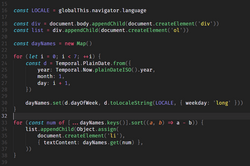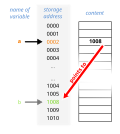Computer programming or coding is the composition of sequences of instructions, called programs, that computers can follow to perform tasks. It involves...
43 KB (4,842 words) - 18:12, 30 July 2025
A computer program is a sequence or set of instructions in a programming language for a computer to execute. It is one component of software, which also...
124 KB (13,091 words) - 13:46, 1 August 2025
In computer programming, a function (also procedure, method, subroutine, routine, or subprogram) is a callable unit of software logic that has a well-defined...
54 KB (6,610 words) - 12:17, 5 August 2025
variables to be among computer science's "most valuable treasures." Donald Knuth, Structured Programming, with go to Statements In computer science, a pointer...
72 KB (9,654 words) - 12:42, 19 July 2025
A programming language is an artificial language for expressing computer programs. Programming languages typically allow software to be written in a human...
64 KB (7,328 words) - 17:57, 3 August 2025
Art of Computer Programming (TAOCP) is a comprehensive multi-volume monograph written by the computer scientist Donald Knuth presenting programming algorithms...
29 KB (2,943 words) - 07:23, 21 July 2025
this, self, and Me are keywords used in some computer programming languages to refer to the object, class, or other entity which the currently running...
24 KB (3,119 words) - 17:19, 5 September 2024
Programmer (redirect from Computer programmer)
A programmer, computer programmer or coder is an author of computer source code – someone with skill in computer programming. The professional titles software...
29 KB (2,613 words) - 08:00, 16 July 2025
In computer science, conditionals (that is, conditional statements, conditional expressions and conditional constructs) are programming language constructs...
38 KB (3,947 words) - 04:37, 27 July 2025
In computer programming, a callback is a function that is stored as data (a reference) and designed to be called by another function – often back to the...
17 KB (1,825 words) - 15:28, 5 August 2025
Program analysis tools are extremely important for understanding program behavior. Computer architects need such tools to evaluate how well programs will...
21 KB (2,292 words) - 22:10, 19 April 2025
In computer programming, a trait is a language concept that represents a set of methods that can be used to extend the functionality of a class. In object-oriented...
22 KB (2,051 words) - 20:38, 4 August 2025
In computer programming, a comment is text embedded in source code that a translator (compiler or interpreter) ignores. Generally, a comment is an annotation...
46 KB (5,121 words) - 19:33, 26 July 2025
object-oriented programming, a class defines the shared aspects of objects created from the class. The capabilities of a class differ between programming languages...
46 KB (4,322 words) - 10:53, 27 July 2025
Skeleton programming is a style of computer programming based on simple high-level program structures and so called dummy code. Program skeletons resemble...
19 KB (2,500 words) - 17:31, 21 May 2025
In computer programming, an operator is a programming language construct that provides functionality that may not be possible to define as a user-defined...
20 KB (1,179 words) - 19:26, 1 August 2025
In computer science, a literal is a textual representation (notation) of a value as it is written in source code. Almost all programming languages have...
4 KB (388 words) - 02:58, 24 July 2024
Parallel computing (redirect from Parallel programming)
brought parallel computing to desktop computers. Thus parallelization of serial programs has become a mainstream programming task. In 2012 quad-core processors...
74 KB (8,380 words) - 19:27, 4 June 2025
Numbers in the Ch Programming Language". Scientific Programming: 76–106. Cheng, Harry (1993). "Scientific Computing in the Ch Programming Language". Scientific...
12 KB (1,197 words) - 18:55, 8 April 2025
In computer programming, a variable is said to be volatile if its value can be read or modified asynchronously by something other than the current thread...
22 KB (2,142 words) - 05:42, 16 May 2025
In some programming languages, const is a type qualifier (a keyword applied to a data type) that indicates that the data is read-only. While this can...
45 KB (5,602 words) - 09:49, 29 July 2025
Asynchrony, in computer programming, refers to the occurrence of events independent of the main program flow and ways to deal with such events. These may...
3 KB (359 words) - 14:21, 30 April 2025
History of Functional Programming Languages" (PDF). International Symposium on Trends in Functional Programming. Lecture Notes in Computer Science. Vol. 7829...
50 KB (6,372 words) - 23:54, 30 July 2025
In computer programming, a declaration is a language construct specifying identifier properties: it declares a word's (identifier's) meaning. Declarations...
8 KB (997 words) - 05:00, 27 August 2024
In computer programming, a parameter, a.k.a. formal argument, is a variable that represents an argument, a.k.a. actual argument, a.k.a. actual parameter...
28 KB (3,596 words) - 11:57, 9 May 2025
In computer programming, a poltergeist (or gypsy wagon) is a short-lived, typically stateless object used to perform initialization or to invoke methods...
3 KB (317 words) - 15:23, 24 October 2024
In computer science, reflective programming or reflection is the ability of a process to examine, introspect, and modify its own structure and behavior...
19 KB (2,030 words) - 18:33, 16 July 2025
A method in object-oriented programming (OOP) is a procedure associated with an object, and generally also a message. An object consists of state data...
15 KB (1,837 words) - 09:33, 29 December 2024
similarity has been explained by programming language theorists in terms of existential types. In object-oriented programming languages, and other related...
16 KB (1,425 words) - 01:02, 16 June 2025
In object-oriented programming, a destructor (sometimes abbreviated dtor) is a method which is invoked mechanically just before the memory of the object...
22 KB (2,418 words) - 13:38, 5 August 2025








